Your cart is currently empty!

Mastering Relationship Marketing: 5 Principles for Building Lasting Customer Connections
Author:

The morning sun filtered through the windows of John’s Custom Bikes, casting a warm glow over the workshop. John, a skilled craftsman with decades of experience, stood admiring his latest creation – a sleek, custom-built racing bike. His wife Mary, the backbone of their business operations, was reviewing their sales reports nearby. Their children, Lance and Marianne, were busy preparing for the day ahead, their enthusiasm for the family business evident in their quick movements and animated chatter.
Positive anticipation filled the room as the family gathered for their weekly marketing meeting. Mary, her brow furrowed in concentration, did not share the optimism of the other family members. She felt compelled to share an observation that had been troubling her.
“I’ve noticed something in our recent sales data,” she began, her voice touched with concern. “We’re getting a lot of one-time, low-value purchases from our digital marketing efforts. It’s great that we’re reaching more people, but…” she paused, looking around at her family, and asked, “How can we attract higher-quality customers?”
The question, hanging in the air, soon sparked a lively discussion. Lance, always quick with ideas, suggested ramping up their social media presence. “Maybe if we showcase more of our high-end models, we’ll attract customers willing to invest in quality,” he proposed.
Marianne, analytical as ever, countered, “But we’ve been increasing our online presence, and it hasn’t changed the pattern. Perhaps we’re not targeting the right audience?”
John listened intently, his weathered hands absently tracing the curves of the bike frame beside him. “You know,” he said slowly, “when my father started this business, he knew every customer by name. He built relationships, not just bikes. Maybe we’ve lost sight of that in our rush to go digital.”
As the family debated, frustration grew. They had embraced digital marketing, but something was missing. Their online efforts were bringing in new customers but not the loyal, high-value patrons they truly wanted.
Mary, sensing the mounting tension, made a suggestion. “Why don’t we invite Kyle to chat with us? He’s helped us navigate the digital world before. Maybe he can shed some light on this issue.”

The family agreed, and a few days later, they found themselves seated around the old oak table in the back of the shop, with Kyle joining them. Mary explained their observations, and the rest of the family chimed in with their theories and concerns.
Kyle listened carefully, his expression thoughtful. When everyone had finished speaking, he leaned forward, a glint in his eyes. “You know,” he began, “I once heard something from a loyalty researcher that’s stuck with me: ‘90% of loyalty problems can be traced to a flawed sales process.’”
The family exchanged puzzled glances as Kyle continued. “What you’re experiencing isn’t uncommon. Many businesses struggle to attract high-quality customers in the digital age. The key lies in relationship marketing and the relationship begins before the sale has happened.”
Kyle went on to briefly explain the five principles of relationship marketing, emphasizing how high-value customers often have a deeper relationship with a business. “To attract these customers,” he said, “you first need to determine who your best customers are.”
He outlined the characteristics of best customers and introduced the concepts of customer avatars and buyer’s journey maps. “I recommend having conversations with your current best customers,” Kyle suggested. “Use an interview guide I’ll provide, and document what you learn using avatar and journey map templates.”
The family listened intently, a new sense of purpose growing among them. Kyle’s final recommendation resonated deeply: “Once you have your best customer avatar and journey map, assess all your digital marketing using these tools. Make the adjustments needed and you will start attracting the high-quality customers you seek.”
As Kyle’s words sank in, the family realized they were about to embark on a new chapter in their business journey—one that would bring them back to the personal connections and relationships that had made John’s Custom Bikes special from the start while leveraging the power of digital marketing to reach the right customers.
In this comprehensive guide, we’ll explore the five key principles of relationship marketing and how you can implement them to elevate your brand, boost customer loyalty, and drive sustainable growth. Whether you’re a small business owner like John and his family or a marketing professional seeking to refine your strategies, this post will provide you with the actionable insights you need to master relationship marketing.
Let’s dive in and unlock the transformative power of relationship marketing together, learning from John’s Custom Bikes’ journey along the way.
The Five Key Principles of Relationship Marketing
You might be asking yourself, “What is relationship marketing?“
At its core, relationship marketing is about shifting your focus from short-term gains to long-term customer value. By nurturing genuine connections with your audience, you create a loyal customer base that not only continues to choose your brand but also becomes your most powerful advocate.
Let’s explore the five relationship marketing principles that will guide your marketing efforts:
1. Attract the Right Customers for the Right Reasons
The foundation of successful relationship marketing lies in attracting customers who align with your brand values and offerings. It’s not about casting the widest net possible, but rather, it’s about targeting those who will truly benefit from your products or services.

- Focus on showcasing your unique value proposition rather than relying on gimmicks or discounts.
- Craft messaging that resonates with your ideal customer avatar, addressing their specific pain points and aspirations and where they are in their journey.
2. Prioritize the Beginning of the Relationship
The initial interactions with a new customer are crucial. This is your opportunity to set the tone for a long-lasting relationship. Remember, a purchase doesn’t automatically equate to loyalty – you need to earn it.

- Create a memorable onboarding experience.
- Go beyond the expected by providing additional value, whether it’s through personalized welcome packages, exclusive content, or unexpected perks that delight your new customers.
3. Continually Reinforce the Decision to Buy
Once you’ve established a connection, it’s vital to keep nurturing it. Your goal is to make customers feel consistently good about choosing your brand, encouraging repeat purchases and long-term loyalty.

- Implement a robust post-purchase communication plan. This could include follow-up emails with usage tips, exclusive offers for repeat customers, or invitations to special events.
- The key is to maintain engagement without being overly salesy.
4. Reward Good Customers
Not all customers are created equal. The Pareto principle often applies in business, where 20% of your customers generate 80% of your revenue. Identifying and rewarding these high-value customers is crucial for maintaining and growing your business.

- Develop a tiered loyalty program that offers increasingly valuable rewards for your best customers.
- This could include early access to new products, personalized services, or exclusive experiences that make them feel truly special.
5. Prioritize Relationships at Risk
Even the strongest relationships can face challenges. When issues arise, especially with your best customers, it’s critical to address them promptly and effectively.

- Establish a proactive customer service approach targeted toward your best customers.
- Monitor customer engagement and satisfaction levels closely. Net Promoter Score is a good tool for this.
- When you notice signs of dissatisfaction, reach out personally to address concerns and rebuild trust. Sometimes, going above and beyond to resolve an issue can actually strengthen the relationship more than if no problem had occurred.
Embracing these five principles lays the foundation for a robust relationship marketing strategy. Remember, the goal is to create an emotional connection with your customers that goes beyond the transactional. When done right, relationship marketing transforms customers into brand ambassadors, driving sustainable growth and success for your business.
Creating a Customer Avatar for Effective Relationship Marketing
To truly excel in relationship marketing, you need to have a deep understanding of your target audience. This is where creating a customer avatar comes into play. A customer avatar, also known as a buyer persona, is a detailed representation of your ideal customer. It goes beyond basic demographics to encompass psychographics, behaviors, and motivations.
Let’s break down the process of creating a comprehensive customer avatar that will guide your relationship marketing efforts:
1. Gather Data
Start by collecting as much information as possible about your existing customers.
Use a combination of:
- Customer surveys and interviews
- Sales data and purchase history
- Website and social media analytics
- Feedback from your sales and customer service teams
Remember, the goal is to focus on your best customers – those who bring in the most revenue and are most aligned with your brand values.
2. Define Demographics
While demographics aren’t everything, they provide a foundation for your avatar.
Include details such as:
- Age range
- Gender
- Location
- Income level
- Education
- Occupation
For B2B businesses, consider company size, industry, and job titles of decision-makers.
3. Identify Characteristics
This is where you dive deeper into the personality and lifestyle of your ideal customer.
Consider:
- Values and beliefs
- Interests and hobbies
- Goals and aspirations
- Challenges and pain points
- Preferred communication styles
4. Map Out the Customer Journey
Understanding how your ideal customer moves through the buying process is crucial for relationship marketing.
Outline:
- How they become aware of their problem or need
- Where they search for information
- What factors influence their decision-making
- How they prefer to make purchases
- What their post-purchase behavior looks like
5. Create a Narrative
Bring your avatar to life by creating a narrative around them. Give them a name, a backstory, and specific scenarios that illustrate their interactions with your brand. This helps make the avatar more relatable and easier for your team to keep in mind when crafting marketing strategies.
6. Identify Pain Points and Gains
Understanding what frustrates your ideal customer and what they hope to achieve is key to creating marketing messages that resonate.
List out:
- Major challenges they face in their personal or professional life
- Specific problems your product or service solves for them
- Goals they want to achieve
- Benefits they gain from using your product or service
7. Refine and Update Regularly
Your customer avatar shouldn’t be a static document. As you gather more data and insights, continuously refine your avatar. Market conditions change, and so do customer preferences and behaviors. Regularly updating your avatar ensures your relationship marketing efforts remain relevant and effective.
Example: Meet Sarah, the Sustainability-Focused Entrepreneur
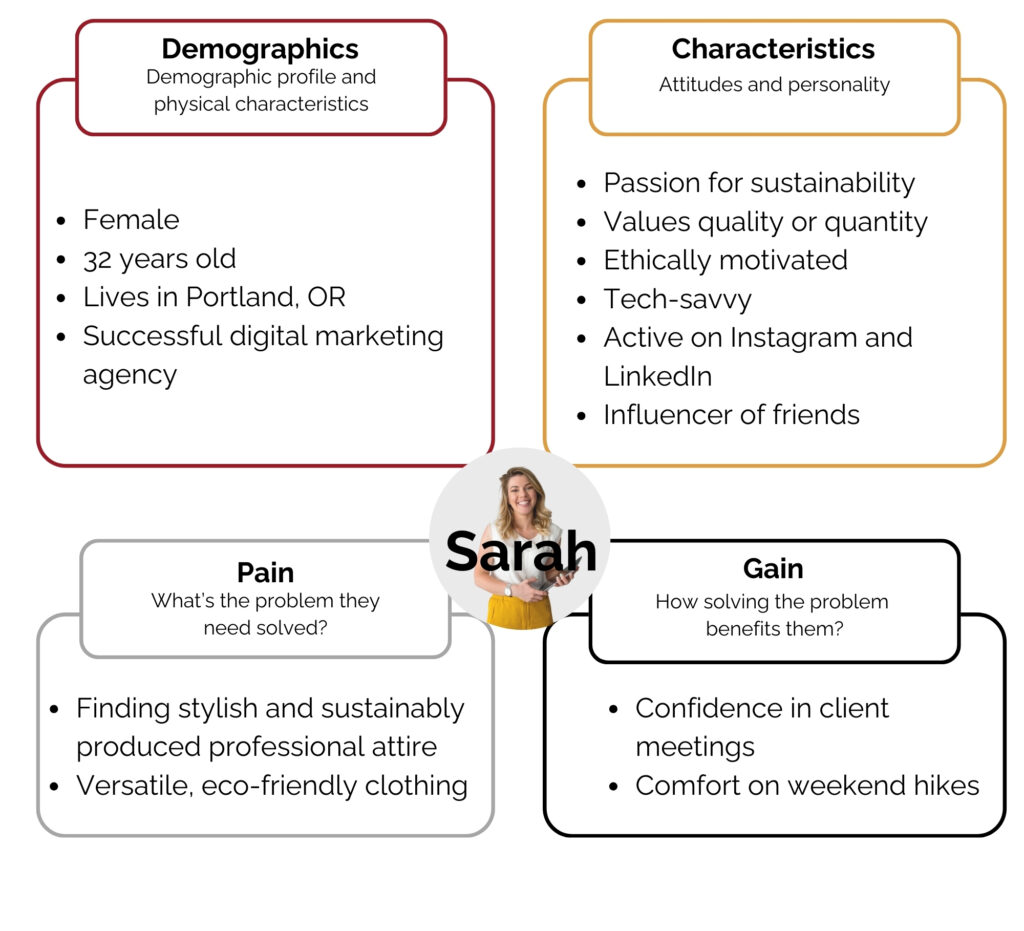
To illustrate, let’s create a quick avatar for a sustainable fashion brand:
Sarah is a 32-year-old entrepreneur living in Portland, Oregon. She runs a successful digital marketing agency and has a passion for sustainability. Sarah values quality over quantity and is willing to pay more for products that align with her ethics. She’s tech-savvy, active on Instagram and LinkedIn, and often influences her friends’ purchasing decisions. Her biggest challenge is finding professional attire that’s both stylish and sustainably produced. She’s looking for a brand that can provide her with versatile, eco-friendly clothing options that make her feel confident in client meetings and comfortable during her weekend hikes.
By creating a detailed avatar like Sarah, you can tailor your relationship marketing efforts to address her specific needs, communicate through her preferred channels, and highlight the aspects of your brand that will resonate most with her values and lifestyle.
Mapping the Customer Journey in Relationship Marketing
Understanding your customer avatar is just the first step. To truly excel in relationship marketing, you need to map out the entire customer journey. This process allows you to identify key touchpoints where you can build and strengthen relationships, creating a seamless and personalized experience that fosters loyalty.
Let’s break down the customer journey mapping process and see how it applies to relationship marketing:
1. Awareness Stage
At this stage, your potential customer becomes aware of a problem or need they have. Your goal is to be present and helpful as they begin their search for solutions.
Relationship Marketing Tactics:
- Create informative content that addresses common pain points
- Offer free resources like e-books or webinars to provide value upfront
- Engage in social listening to join relevant conversations
- Use targeted ads to reach potential customers with helpful information
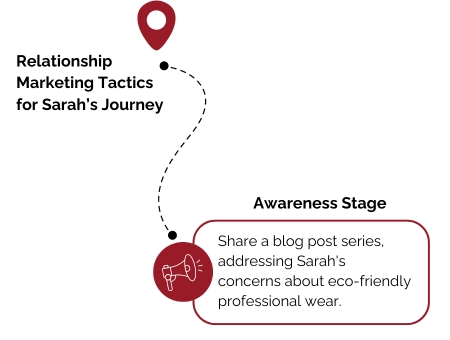
Example: Share a blog post series on sustainable fashion myths, addressing Sarah’s concerns about eco-friendly professional wear.
2. Consideration Stage
Now that the customer is aware of potential solutions, they’re actively researching and comparing options. This is your opportunity to showcase your expertise and build trust.
Relationship Marketing Tactics:
- Provide detailed product information and comparisons
- Offer personalized consultations or product demos
- Share customer testimonials and case studies
- Create engaging email sequences that nurture leads with valuable content
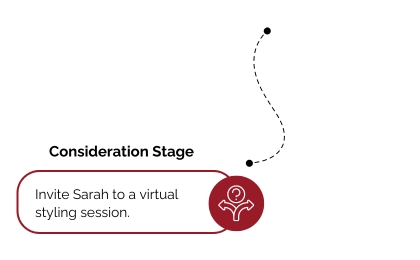
Example: Invite Sarah to a virtual styling session where she can learn how to create a sustainable capsule wardrobe for work.
3. Decision Stage
The customer is ready to make a purchase. Your goal is to make this process as smooth as possible while reinforcing that they’re making the right choice.
Relationship Marketing Tactics:
- Offer exceptional customer service during the purchase process
- Provide clear and transparent information about pricing, shipping, and policies
- Send a personalized thank-you message after the purchase
- Include a small gift or unexpected bonus with their order
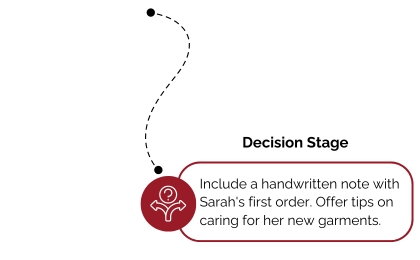
Example: Include a handwritten note with Sarah’s first order, thanking her for choosing sustainable fashion and offering tips on how to care for her new garments.
4. Retention Stage
After the purchase, your focus shifts to keeping the customer happy and encouraging repeat business. This is where relationship marketing really shines.
Relationship Marketing Tactics:
- Implement a loyalty program that rewards repeat purchases
- Send personalized product recommendations based on past purchases
- Offer exclusive access to new products or sales for existing customers
- Provide ongoing value through educational content or members-only events

Example: Invite Sarah to join a VIP program for sustainable fashion enthusiasts, offering early access to new collections and invitations to eco-focused networking events.
5. Advocacy Stage
Your ultimate goal is to turn satisfied customers into brand advocates who will recommend your business to others.
Relationship Marketing Tactics:
- Create a referral program that rewards customers for bringing in new business
- Encourage and showcase user-generated content
- Engage with customers on social media and feature their stories
- Involve loyal customers in product development or feedback sessions
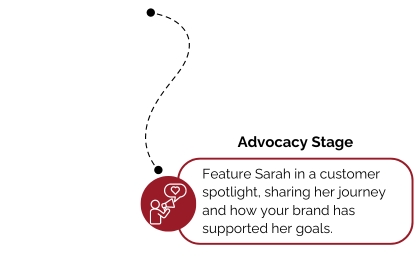
Example: Feature Sarah in a customer spotlight, sharing her journey towards a more sustainable wardrobe and how your brand has supported her goals.
6. Continuous Improvement
The customer journey isn’t static. Regularly gather feedback and analyze data to identify areas for improvement.
Relationship Marketing Tactics:
- Conduct regular customer satisfaction surveys
- Analyze customer behavior data to identify trends and pain points
- Host focus groups or one-on-one interviews with loyal customers
- Use AI and machine learning to personalize experiences at scale
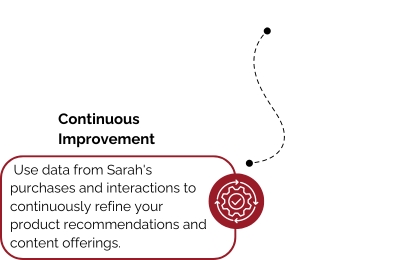
Example: Use data from Sarah’s purchases and interactions to continuously refine your product recommendations and content offerings.
By mapping out each stage of the customer journey and implementing targeted relationship marketing tactics, you create a cohesive experience that nurtures strong, lasting connections with your customers. Remember, the goal is not just to make a sale, but to create a relationship that extends far beyond the initial transaction.
Developing a Relationship-Focused Marketing Funnel
While traditional marketing funnels focus primarily on moving prospects toward a purchase, a relationship-focused funnel aims to nurture long-term connections. Let’s explore how to structure your funnel to support relationship marketing:
1. Top of the Funnel: Awareness and Education
- Create valuable content that addresses your avatar’s pain points
- Use social media to engage in meaningful conversations
- Offer free resources that provide immediate value

2. Middle of the Funnel: Trust-Building and Engagement
- Provide more in-depth content like webinars or case studies
- Implement email nurture sequences that offer personalized value
- Encourage two-way communication through surveys or feedback requests

3. Bottom of the Funnel: Conversion and Beyond
- Offer personalized product recommendations
- Provide exceptional customer service during the purchase process
- Implement a strong onboarding process for new customers

4. Post-Purchase: Retention and Advocacy
- Create a loyalty program that rewards ongoing engagement
- Provide exclusive content or early access to loyal customers
- Encourage and facilitate customer reviews and testimonials

I want to call out the importance of mid-funnel for relationship building. It’s an often underutilized part of the marketing funnel that, when used properly, will start the relationship-building process early in the buyer’s journey.
And remember, the journey doesn’t end with a purchase in a relationship-focused funnel. It’s an ongoing cycle of engagement, value provision, and trust-building.
Implementing Relationship Marketing Strategies in Your Business
Now that we’ve covered the principles, customer avatar creation, journey mapping, and funnel development, let’s discuss practical strategies for implementing relationship marketing:
1. Personalization at Scale
- Use marketing automation tools to deliver personalized content
- Segment your email list based on customer behaviors and preferences
- Implement AI-driven product recommendations on your website
2. Community Building
- Create a branded online community or forum for customers
- Host virtual or in-person events to facilitate connections
- Encourage user-generated content and peer-to-peer support
3. Exceptional Customer Service
- Implement omnichannel support for seamless customer experiences
- Train your team to go above and beyond in resolving issues
- Use customer feedback to continuously improve your products and services
4. Content Marketing for Relationship Building
- Develop a content strategy that addresses all stages of the customer journey
- Create interactive content that encourages engagement
- Use storytelling to create emotional connections with your brand
5. Leveraging Technology
- Implement a robust CRM system to track customer interactions
- Use predictive analytics to anticipate customer needs
- Explore emerging technologies like VR or AR for immersive experiences
Measuring the Success of Your Relationship Marketing Efforts
To ensure your relationship marketing strategies are effective, you need to track the right metrics:
- Customer Lifetime Value (CLV)
- Net Promoter Score (NPS)
- Customer Retention Rate
- Engagement Rates (email opens, social media interactions, etc.)
- Referral Rate
- Customer Satisfaction Score (CSAT)
- Repeat Purchase Rate
Regularly analyze these metrics and use the insights to refine your strategies.
Conclusion: The Fruits of Relationship Marketing
Six months had passed since Kyle’s visit to John’s Custom Bikes. The workshop hummed with its usual activity, but there was a new energy in the air—a sense of purpose and excitement that hadn’t existed before.
The family gathered once again around the old oak table, this time to review the results of their updated marketing plan. John sat at the head of the table, a proud smile playing on his lips as he looked at his family.
Mary, armed with a stack of reports, began the meeting. “I can hardly believe the difference,” she said, her voice filled with enthusiasm. “Our customer lifetime value has increased by 30% in just six months!”
Lance chimed in, “And it’s not just the numbers. The engagement on our social media is through the roof. Remember that series we did on the custom bike build for the local cycling champ? It went viral!”
Marianne nodded in agreement. “Our email open rates have doubled, and we’re seeing a significant increase in repeat purchases. It seems our customers are really resonating with the personalized content we’re sending.”
John leaned forward, his eyes twinkling. “You know what I love most? The conversations I’m having with customers. They’re not just buying bikes; they’re becoming part of our community. Yesterday, I spent an hour chatting with a customer online about his upcoming cross-country ride. That’s the kind of connection I remember from when my father ran the shop.”
Mary smiled warmly at her husband before continuing. “Our customer retention rate has improved dramatically. And the referrals! We’re seeing a 50% increase in new customers coming from referrals.”
“Don’t forget about the loyalty program,” Lance added. “The exclusive events and early access to new models have been a huge hit. Our best customers feel truly valued.”
Marianne pulled up a chart on her laptop. “And look at this – our Net Promoter Score has shot up. People aren’t just satisfied; they’re actively recommending us to others.”
John nodded, taking it all in. “It’s amazing what a difference understanding our best customers has made. By focusing on building genuine relationships, we’ve not only grown our business but created a community around our brand.”
The family fell into a moment of reflective silence, each considering the journey they’d been on. It hadn’t always been easy. Implementing the new strategies had required consistent effort, a willingness to adapt, and a genuine commitment to their customers. But the rewards – increased loyalty, higher lifetime value, and sustainable growth – had been worth every ounce of effort.
Mary was the first to break the silence. “You know, this journey has taught me something important. Relationship marketing isn’t just a strategy; it’s a mindset. It’s about truly caring for our customers and always striving to provide value beyond just our products. What did Kyle call this?”
Marianne responded, “He called it relationship equity. It’s the value that we add that goes past the transaction.”
John nodded in agreement. “And we can’t stop. We need to keep listening to our customers, adapting to their needs, and finding new ways to strengthen our connections with them.”
Relationship marketing isn’t just a strategy; it’s a mindset. It’s about truly caring for customers and always striving to provide value beyond just products.
Lance grinned. His enthusiasm was infectious and a bit over the top. “I can’t wait to see where we go from here. We’re not just selling bikes anymore; we’re building a movement!” The family groaned in unison.
As the meeting wound down, John and his family shared a moment of pride and excitement for the future. They had transformed their marketing approach and built a community of loyal customers. John’s Custom Bikes wasn’t just surviving in the digital age; it was thriving, powered by the strength of genuine connections and the principles of relationship marketing.
The last rays of the setting sun streamed through the workshop windows, illuminating the family as they stood together, ready to pedal into a bright future. Their journey was far from over, but with their newfound understanding of relationship marketing, they were equipped to face whatever challenges lay ahead, one customer relationship at a time.
Related Posts
-
Your Funnel is Built for Another Generation
Is your marketing talking to the wrong generation? Does this matter? Find out.
-
Don’t Shout About Features, Connect With Solutions
Learn how marketing that connects with best customers breaks through the noise and drives growth.
-
Write Better Headlines
Discover 10 tips to craft compelling headlines that captivate readers and boost engagement.
Author: James Hipkin
Since 2010, James Hipkin has built his clients’ businesses with digital marketing. Today, James is passionate about websites and helping the rest of us understand online marketing. His customers value his jargon-free, common-sense approach. “James explains the ins and outs of digital marketing in ways that make sense.”
Use this link to book a meeting time with James.

